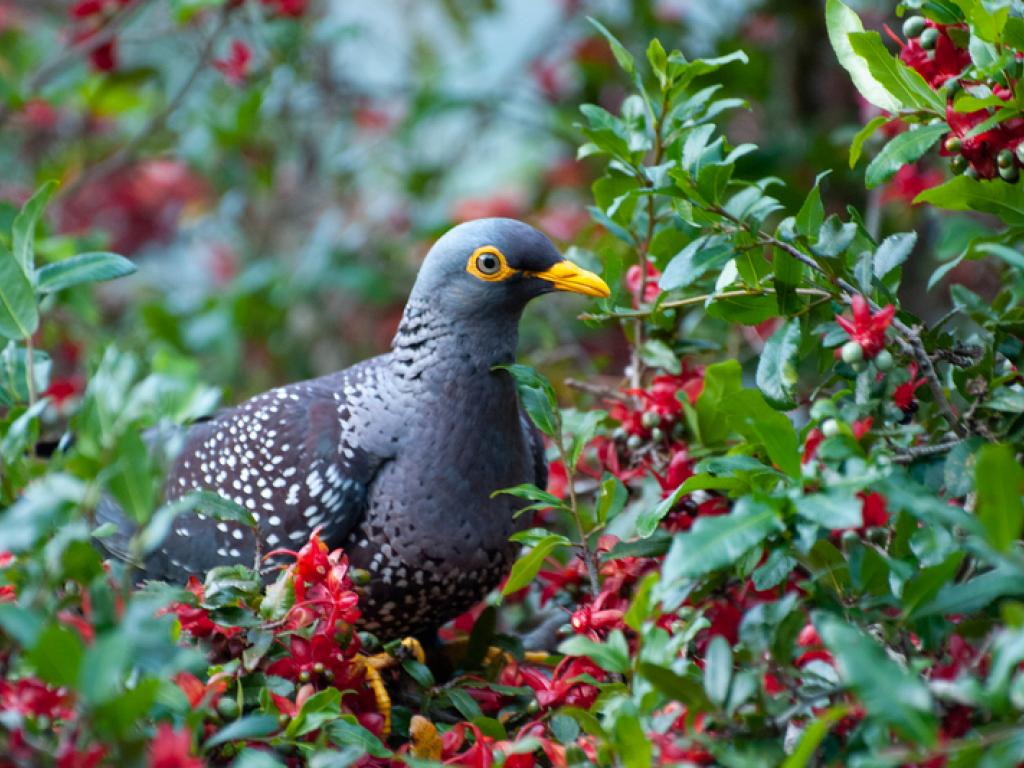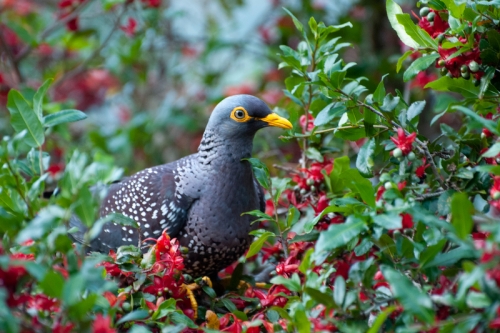Snobbish birds prefer to live in luxury


A new study shows that South African birds, like this African Olive Pigeon, prefer to live in higher income areas.
A unique study of birdlife in South African cities has found that birds prefer wealthy areas to poorer ones but will move out if things get too cramped. The study was conducted by a team of scientists from the University of Turin, Italy and the Universities of Cape Town (UCT) and the Witwatersrand, South Africa. Their findings were published this week in the international journal of Global Change Biology.
Co-author on the study, Associate Professor Arjun Amar from the Department of Biological Sciences at UCT, said: “This work is of particular importance because it is one of the few studies conducted in a developing country, and the only study of its kind in Africa, where urbanisation is predicted to occur at a faster rate than any other region on the planet.”
City soundscapes may not be famous for their birdsong, but the new study has revealed that the richer the neighbourhood, the more bird species are found there – as long as there is still enough good habitat for them to spread their wings.
The researchers studied birdlife in 22 urban areas across South Africa and found that species richness increased according to the income level of the neighbourhood, but not in highly urbanised areas where vegetation has all but disappeared.
The so-called ‘luxury effect’ – well-documented in the developed world – also applies to relatively low-density urban areas in South Africa, where rich areas have a greater diversity of bird species than poor areas. This is probably because in wealthier neighbourhoods there is more investment in gardens, parks and other green spaces – hotspots of urban biodiversity. However, birds have no appetite for heavily built-up areas, even when they have wealthy inhabitants.
This is the first time the ‘luxury effect’ in birds has been documented in Africa.
In wealthier neighbourhoods there is more investment in gardens, parks and other green spaces – hotspots of urban biodiversity.
The researchers believe such findings could help shape future urban planning in the interests of both biodiversity and environmental justice, particularly in the rapidly urbanising developing world.
Higher biodiversity
“This study shows that rich, leafy suburbs have more bird species and very probably higher biodiversity, in general, than either poor areas of the city or any areas that have too much asphalt and concrete,” said lead author Professor Dan Chamberlain from the University of Turin. “Understanding the factors that drive the ‘luxury effect’ will help us to design more biodiversity-friendly cities in the future, thus promoting environmental justice for all urban inhabitants.”
“This work is of particular importance because it is one of the few studies conducted in a developing country,” said co-author UCT Associate Professor Arjun Amar. “Also it's the only study of its kind in Africa, which is predicted to urbanise in the future at a faster rate than any other region on the planet.”
Findings were based on careful analysis of four years of data from the Southern African Bird Atlas Project across a range of urban environments, ranging from peri-urban outskirts to high-rise city centres, where average annual income varied between USD1 000 to USD30 000 according to the South African census data, which were used in the study.
Researchers also confirmed a predictable link between the amount of urban tree cover and bird diversity. However, the authors conclude that tree cover alone does not fully explain the luxury effect.
Valuable case study
The authors described South Africa as “an extremely valuable case study” of the relationship between wealth and biodiversity due to the country’s species richness – it’s home to 10% of the world’s terrestrial plants and 7% of terrestrial reptiles, birds and mammals – and infamous levels of income inequality.
The authors described South Africa as 'an extremely valuable case study' of the relationship between wealth and biodiversity due to the country’s species richness.
The study concludes that “maintaining green space in at least an equal proportion to the built environment is likely to provide a development strategy that will enhance urban biodiversity, and with it, the positive benefits that are manifest for urban dwellers.”
The authors say they hope that the “findings can form a key contribution to a wider strategy to expand urban settlements in a sustainable way to provide for the growing urban population in South Africa, including addressing imbalances in environmental justice across income levels and racial groups.”
Chamberlain DE, Henry DAW, Reynolds C, Caprio E & Amar A (2019) The relationship between wealth and biodiversity: A test of the Luxury Effect on bird species richness in the developing world. Global Change Biology.
Story: Supplied
Photo: Dominic Henry
